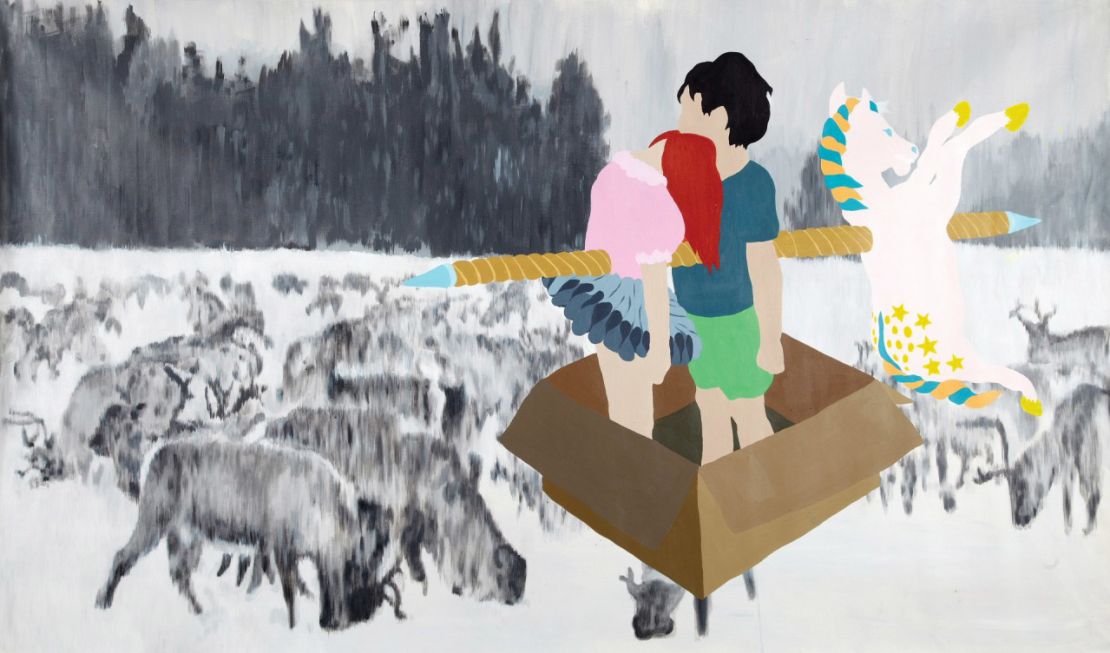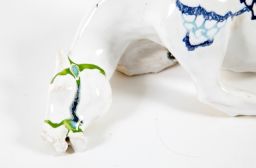Tess Dumon didn’t know whether her brother was alive or dead.
Fourteen-year-old Louis had suffered seizures almost all his life, but this time he wouldn’t wake up.
“I witnessed my mother holding his lifeless body in her arms,” Dumon recalls of that traumatic day at her family’s home in Switzerland 12 years ago.
“He’d had one of his frequent epilepsy crises that made him convulse, distort, fall and drool. However, something came up with this one, something unusual. My brother was not reacting to our calls and our light slaps,” she said.
“Time had stopped.”
After being rushed to hospital, the family endured an agonizing wait as Louis, who is also autistic, remained in a coma for several hours before finally coming around.
Art as therapy
The horrifying spectacle would leave a lasting impression on the then 12-year-old Tess, who turned to art as a form of therapy.
Initially, she explored the familial connection through sketches and drawings – some graphically depicting her sense of pain and dislocation – before progressing to ceramics, making small equine figurines inspired by her brother’s experience with horse therapy.

“I didn’t know how to interact with him – he cannot speak at all – but then I saw him doing horse therapy. Horses are well known for having interactions with the disabled and people with trauma.
“I was just observing a lot, and when I started doing art it was the central theme in my work.”
Equine-assisted therapy is an increasingly popular alternative treatment for people seeking help with a range of psychological disorders from depression to phobias.

According to the U.S.-based Autism Spectrum Disorder Foundation, autistic children can benefit from the motor, emotional and sensory sensations that come with riding a horse.
Louis, now 26, has been going to Geneva for horse therapy for more than a decade.
“I just feel it’s the right place for him – it calms him,” she says.
“He doesn’t talk but he feels more alive around horses than when he’s on his own. He usually breathes very heavily, and can be quite excited and won’t sit still, (but around horses) he’s just calm.”
Dumon had planned to do a business management degree but was encouraged to pursue a more creative career path by her art-loving parents. “They always took me to museums,” she says.
‘Magic and surprise’
It was while studying at London’s Central St. Martins college that Dumon started making much larger sculptures, creating her award-winning graduate show piece “Stabat Mater (Lorasifar, Depakin, Tegretol & Circadin)” – her boldest artistic response to her brother’s epilepsy crisis to date.
EPILEPSY
The title references the medieval Latin hymn about Mary’s suffering at the crucifixion, while listing Louis’ four epilepsy medications in brackets.
The four horse sculptures, made entirely from chicken wire, were suspended in the college’s atrium last year.
“What I like with the chicken wire is that you can see through them – there is a lightness, a transparency,” she says.
“I really liked this idea of having them flying around. There was magic and surprise when we hung it.”
The 24-year-old is halfway through a two-year Masters degree at London’s Royal College of Art but her work is starting to get noticed outside artistic circles.
In May, Ascot racecourse commissioned the French artist to create a sculpture for this weekend’s King George VI meeting.
Racegoers will have the chance to view her depiction of leading European colt, Charm Spirit, in full flow.
Her handiwork, which took three and a half weeks to complete, has been covered with flowers for the July 24-25 event.
“I was completely thrilled. I hadn’t made any horses since last year so I was very happy to make another one,” she says.
Dumon isn’t sure what the future holds, but expects the horse theme to continue in some form – not least because it helps shine a light on autism.
“Horses are my signature in a way, and really translate my relationship with my brother and the way I see him and the way he interacts with the world,” she says.
“Every time people ask me about my work I am very happy that they are interested in my brother and about autism in general.
“It’s good to help because usually people don’t know how to ask the right question.”














